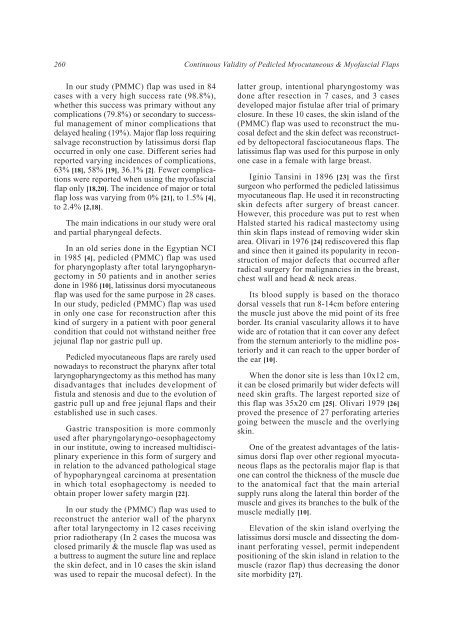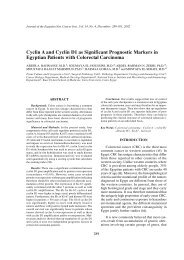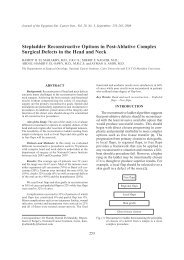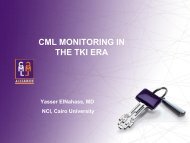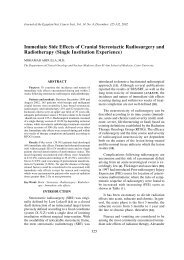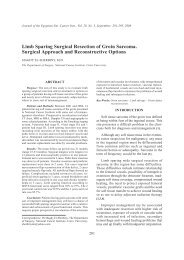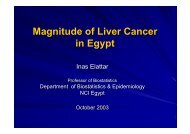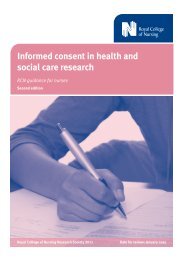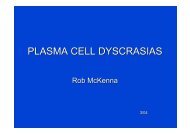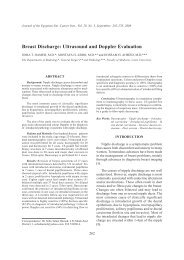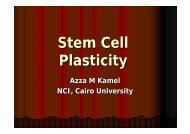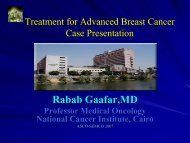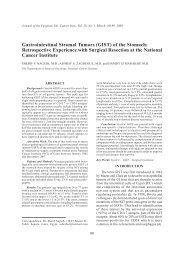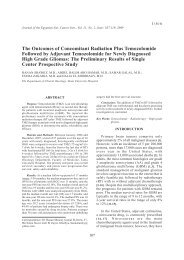Continuous Validity of Pedicled Myocutaneous and Myofascial ... - NCI
Continuous Validity of Pedicled Myocutaneous and Myofascial ... - NCI
Continuous Validity of Pedicled Myocutaneous and Myofascial ... - NCI
Create successful ePaper yourself
Turn your PDF publications into a flip-book with our unique Google optimized e-Paper software.
260<br />
<strong>Continuous</strong> <strong>Validity</strong> <strong>of</strong> <strong>Pedicled</strong> <strong>Myocutaneous</strong> & My<strong>of</strong>ascial Flaps<br />
In our study (PMMC) flap was used in 84<br />
cases with a very high success rate (98.8%),<br />
whether this success was primary without any<br />
complications (79.8%) or secondary to successful<br />
management <strong>of</strong> minor complications that<br />
delayed healing (19%). Major flap loss requiring<br />
salvage reconstruction by latissimus dorsi flap<br />
occurred in only one case. Different series had<br />
reported varying incidences <strong>of</strong> complications,<br />
63% [18], 58% [19], 36.1% [2]. Fewer complications<br />
were reported when using the my<strong>of</strong>ascial<br />
flap only [18,20]. The incidence <strong>of</strong> major or total<br />
flap loss was varying from 0% [21], to 1.5% [4],<br />
to 2.4% [2,18].<br />
The main indications in our study were oral<br />
<strong>and</strong> partial pharyngeal defects.<br />
In an old series done in the Egyptian <strong>NCI</strong><br />
in 1985 [4], pedicled (PMMC) flap was used<br />
for pharyngoplasty after total laryngopharyngectomy<br />
in 50 patients <strong>and</strong> in another series<br />
done in 1986 [10], latissinus dorsi myocutaneous<br />
flap was used for the same purpose in 28 cases.<br />
In our study, pedicled (PMMC) flap was used<br />
in only one case for reconstruction after this<br />
kind <strong>of</strong> surgery in a patient with poor general<br />
condition that could not withst<strong>and</strong> neither free<br />
jejunal flap nor gastric pull up.<br />
<strong>Pedicled</strong> myocutaneous flaps are rarely used<br />
nowadays to reconstruct the pharynx after total<br />
laryngopharyngectomy as this method has many<br />
disadvantages that includes development <strong>of</strong><br />
fistula <strong>and</strong> stenosis <strong>and</strong> due to the evolution <strong>of</strong><br />
gastric pull up <strong>and</strong> free jejunal flaps <strong>and</strong> their<br />
established use in such cases.<br />
Gastric transposition is more commonly<br />
used after pharyngolaryngo-oesophagectomy<br />
in our institute, owing to increased multidisciplinary<br />
experience in this form <strong>of</strong> surgery <strong>and</strong><br />
in relation to the advanced pathological stage<br />
<strong>of</strong> hypopharyngeal carcinoma at presentation<br />
in which total esophagectomy is needed to<br />
obtain proper lower safety margin [22].<br />
In our study the (PMMC) flap was used to<br />
reconstruct the anterior wall <strong>of</strong> the pharynx<br />
after total laryngectomy in 12 cases receiving<br />
prior radiotherapy (In 2 cases the mucosa was<br />
closed primarily & the muscle flap was used as<br />
a buttress to augment the suture line <strong>and</strong> replace<br />
the skin defect, <strong>and</strong> in 10 cases the skin isl<strong>and</strong><br />
was used to repair the mucosal defect). In the<br />
latter group, intentional pharyngostomy was<br />
done after resection in 7 cases, <strong>and</strong> 3 cases<br />
developed major fistulae after trial <strong>of</strong> primary<br />
closure. In these 10 cases, the skin isl<strong>and</strong> <strong>of</strong> the<br />
(PMMC) flap was used to reconstruct the mucosal<br />
defect <strong>and</strong> the skin defect was reconstructed<br />
by deltopectoral fasciocutaneous flaps. The<br />
latissimus flap was used for this purpose in only<br />
one case in a female with large breast.<br />
Iginio Tansini in 1896 [23] was the first<br />
surgeon who performed the pedicled latissimus<br />
myocutaneous flap. He used it in reconstructing<br />
skin defects after surgery <strong>of</strong> breast cancer.<br />
However, this procedure was put to rest when<br />
Halsted started his radical mastectomy using<br />
thin skin flaps instead <strong>of</strong> removing wider skin<br />
area. Olivari in 1976 [24] rediscovered this flap<br />
<strong>and</strong> since then it gained its popularity in reconstruction<br />
<strong>of</strong> major defects that occurred after<br />
radical surgery for malignancies in the breast,<br />
chest wall <strong>and</strong> head & neck areas.<br />
Its blood supply is based on the thoraco<br />
dorsal vessels that run 8-14cm before entering<br />
the muscle just above the mid point <strong>of</strong> its free<br />
border. Its cranial vascularity allows it to have<br />
wide arc <strong>of</strong> rotation that it can cover any defect<br />
from the sternum anteriorly to the midline posteriorly<br />
<strong>and</strong> it can reach to the upper border <strong>of</strong><br />
the ear [10].<br />
When the donor site is less than 10x12 cm,<br />
it can be closed primarily but wider defects will<br />
need skin grafts. The largest reported size <strong>of</strong><br />
this flap was 35x20 cm [25]. Olivari 1979 [26]<br />
proved the presence <strong>of</strong> 27 perforating arteries<br />
going between the muscle <strong>and</strong> the overlying<br />
skin.<br />
One <strong>of</strong> the greatest advantages <strong>of</strong> the latissimus<br />
dorsi flap over other regional myocutaneous<br />
flaps as the pectoralis major flap is that<br />
one can control the thickness <strong>of</strong> the muscle due<br />
to the anatomical fact that the main arterial<br />
supply runs along the lateral thin border <strong>of</strong> the<br />
muscle <strong>and</strong> gives its branches to the bulk <strong>of</strong> the<br />
muscle medially [10].<br />
Elevation <strong>of</strong> the skin isl<strong>and</strong> overlying the<br />
latissimus dorsi muscle <strong>and</strong> dissecting the dominant<br />
perforating vessel, permit independent<br />
positioning <strong>of</strong> the skin isl<strong>and</strong> in relation to the<br />
muscle (razor flap) thus decreasing the donor<br />
site morbidity [27].


